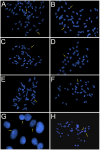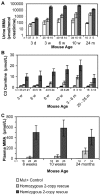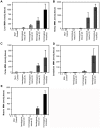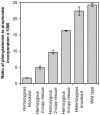Mouse models for methylmalonic aciduria
- PMID: 22792386
- PMCID: PMC3392231
- DOI: 10.1371/journal.pone.0040609
Mouse models for methylmalonic aciduria
Abstract
Methylmalonic aciduria (MMA) is a disorder of organic acid metabolism resulting from a functional defect of methylmalonyl-CoA mutase (MCM). MMA is associated with significant morbidity and mortality, thus therapies are necessary to help improve quality of life and prevent renal and neurological complications. Transgenic mice carrying an intact human MCM locus have been produced. Four separate transgenic lines were established and characterised as carrying two, four, five or six copies of the transgene in a single integration site. Transgenic mice from the 2-copy line were crossed with heterozygous knockout MCM mice to generate mice hemizygous for the human transgene on a homozygous knockout background. Partial rescue of the uniform neonatal lethality seen in homozygous knockout mice was observed. These rescued mice were significantly smaller than control littermates (mice with mouse MCM gene). Biochemically, these partial rescue mice exhibited elevated methylmalonic acid levels in urine, plasma, kidney, liver and brain tissue. Acylcarnitine analysis of blood spots revealed elevated propionylcarnitine levels. Analysis of mRNA expression confirms the human transgene is expressed at higher levels than observed for the wild type, with highest expression in the kidney followed closely by brain and liver. Partial rescue mouse fibroblast cultures had only 20% of the wild type MCM enzyme activity. It is anticipated that this humanised partial rescue mouse model of MMA will enable evaluation of long-term pathophysiological effects of elevated methylmalonic acid levels and be a valuable model for the investigation of therapeutic strategies, such as cell transplantation.
Conflict of interest statement
Figures









Similar articles
-
Development of transgenic mice containing an introduced stop codon on the human methylmalonyl-CoA mutase locus.PLoS One. 2012;7(9):e44974. doi: 10.1371/journal.pone.0044974. Epub 2012 Sep 14. PLoS One. 2012. PMID: 23024777 Free PMC article.
-
A knock-out mouse model for methylmalonic aciduria resulting in neonatal lethality.J Biol Chem. 2003 Dec 26;278(52):52909-13. doi: 10.1074/jbc.M310533200. Epub 2003 Oct 10. J Biol Chem. 2003. PMID: 14555645
-
Tricarboxylic acid cycle enzyme activities in a mouse model of methylmalonic aciduria.Mol Genet Metab. 2019 Dec;128(4):444-451. doi: 10.1016/j.ymgme.2019.10.007. Epub 2019 Oct 17. Mol Genet Metab. 2019. PMID: 31648943 Free PMC article.
-
Systematic literature review and meta-analysis on the epidemiology of methylmalonic acidemia (MMA) with a focus on MMA caused by methylmalonyl-CoA mutase (mut) deficiency.Orphanet J Rare Dis. 2019 Apr 25;14(1):84. doi: 10.1186/s13023-019-1063-z. Orphanet J Rare Dis. 2019. PMID: 31023387 Free PMC article.
-
Role of vitamin B12 on methylmalonyl-CoA mutase activity.J Zhejiang Univ Sci B. 2012 Jun;13(6):423-37. doi: 10.1631/jzus.B1100329. J Zhejiang Univ Sci B. 2012. PMID: 22661206 Free PMC article. Review.
Cited by
-
Correction of methylmalonic aciduria in vivo using a codon-optimized lentiviral vector.Hum Gene Ther. 2014 Jun;25(6):529-38. doi: 10.1089/hum.2013.111. Epub 2014 Apr 2. Hum Gene Ther. 2014. PMID: 24568291 Free PMC article.
-
Hepatic Effects of Pharmacological Doses of Hydroxy-Cobalamin[c-lactam] in Mice.PLoS One. 2017 Jan 30;12(1):e0171026. doi: 10.1371/journal.pone.0171026. eCollection 2017. PLoS One. 2017. PMID: 28135329 Free PMC article.
-
Functional Analysis of A Novel Splicing Mutation in The Mutase Gene of Two Unrelated Pedigrees.Cell J. 2016 Fall;18(3):397-404. doi: 10.22074/cellj.2016.4568. Epub 2016 Aug 24. Cell J. 2016. PMID: 27602322 Free PMC article.
-
Gene Therapy for Methylmalonic Acidemia: Past, Present, and Future.Hum Gene Ther. 2019 Oct;30(10):1236-1244. doi: 10.1089/hum.2019.113. Epub 2019 Aug 16. Hum Gene Ther. 2019. PMID: 31303064 Free PMC article. Review.
-
Biochemical and anaplerotic applications of in vitro models of propionic acidemia and methylmalonic acidemia using patient-derived primary hepatocytes.Mol Genet Metab. 2020 Jul;130(3):183-196. doi: 10.1016/j.ymgme.2020.05.003. Epub 2020 May 11. Mol Genet Metab. 2020. PMID: 32451238 Free PMC article.
References
-
- Chace DH, DiPerna JC, Kalas TA, Johnson RW, Naylor EW. Rapid diagnosis of methylmalonic and propionic acidemias: quantitative tandem mass spectrometric analysis of propionylcarnitine in filter-paper blood specimens obtained from newborns. Clin Chem. 2001;47:2040–2044. - PubMed
-
- Lindblad B, Lindblad BS, Olin P, Svanberg B, Zetterstrom R. Methylmalonic acidemia. A disorder associated with acidosis, hyperglycinemia, and hyperlactatemia. Acta Paediatr Scand. 1968;57:417–424. - PubMed
-
- Matsui SM, Mahoney MJ, Rosenberg LE. The natural history of the inherited methylmalonic acidemias. N Engl J Med. 1983;308:857–861. - PubMed
-
- Feillet F, Bodamer OA, Dixon MA, Sequeira S, Leonard JV. Resting energy expenditure in disorders of propionate metabolism. J Pediatr. 2000;136:659–663. - PubMed
Publication types
MeSH terms
Substances
Supplementary concepts
LinkOut - more resources
Full Text Sources
Other Literature Sources
Medical
Molecular Biology Databases

